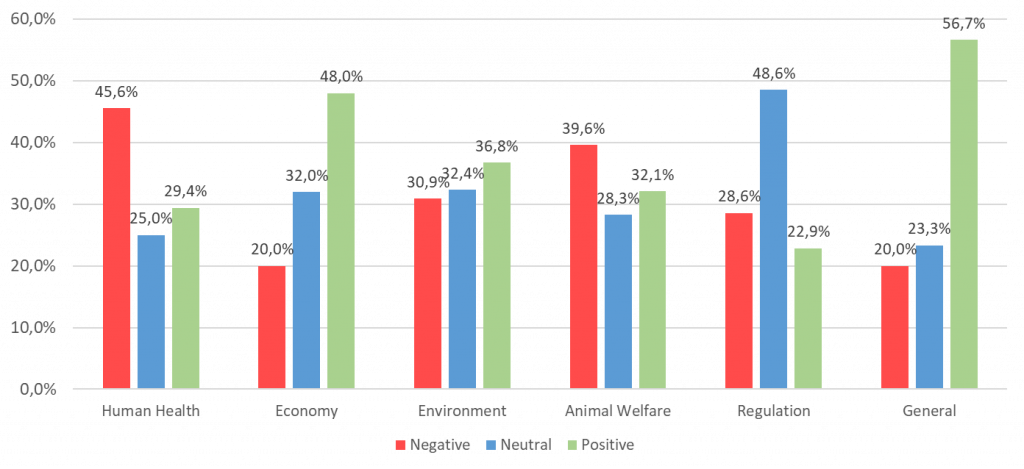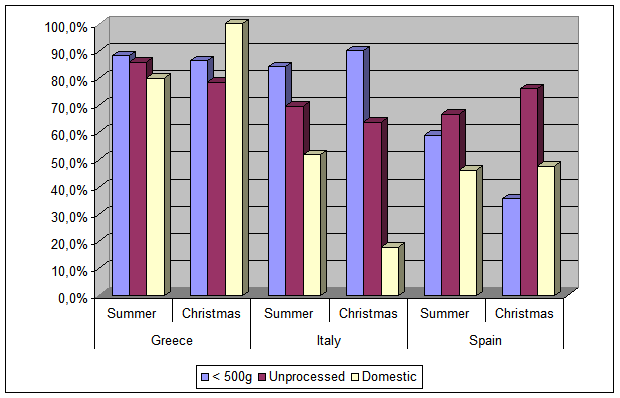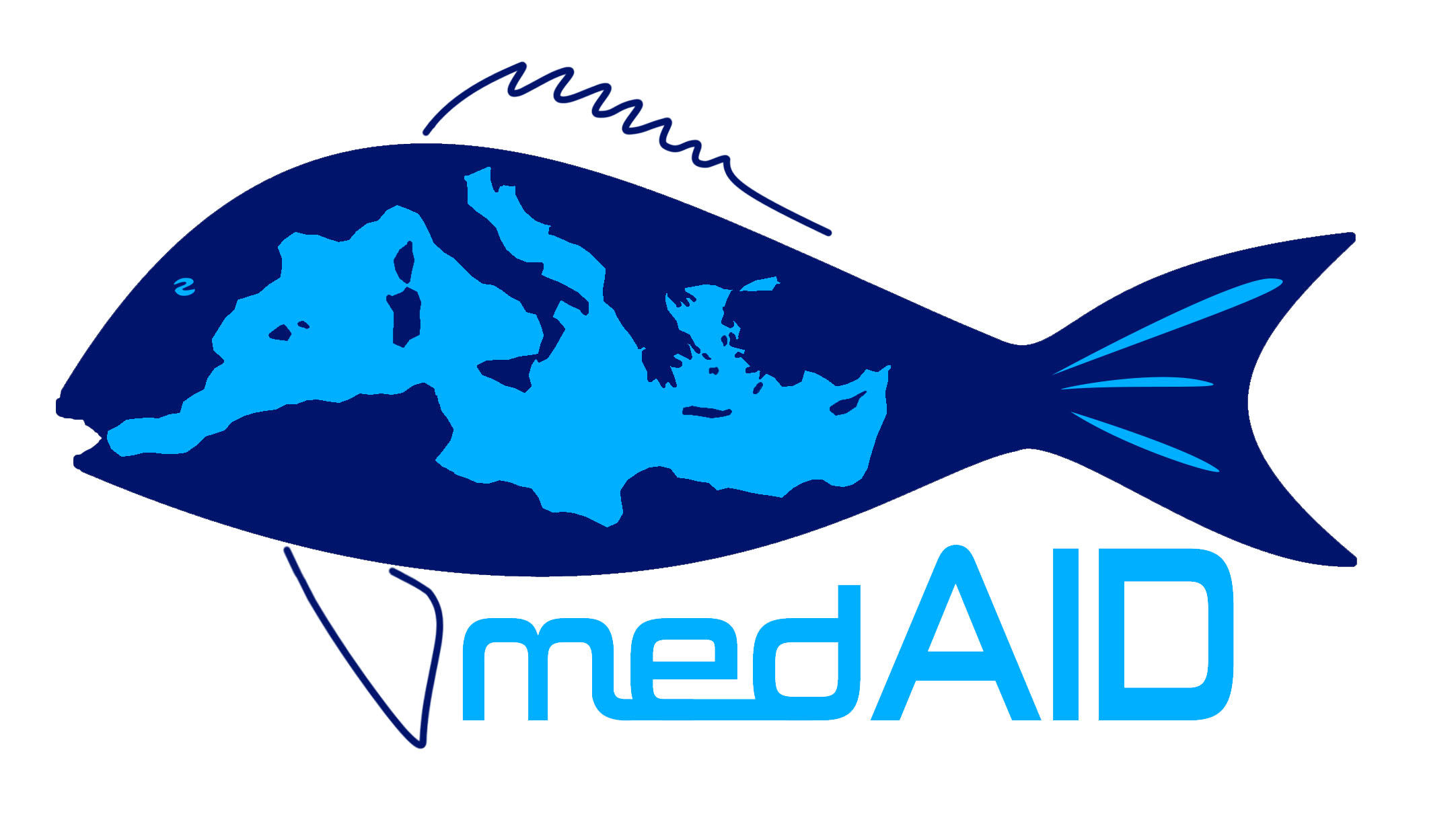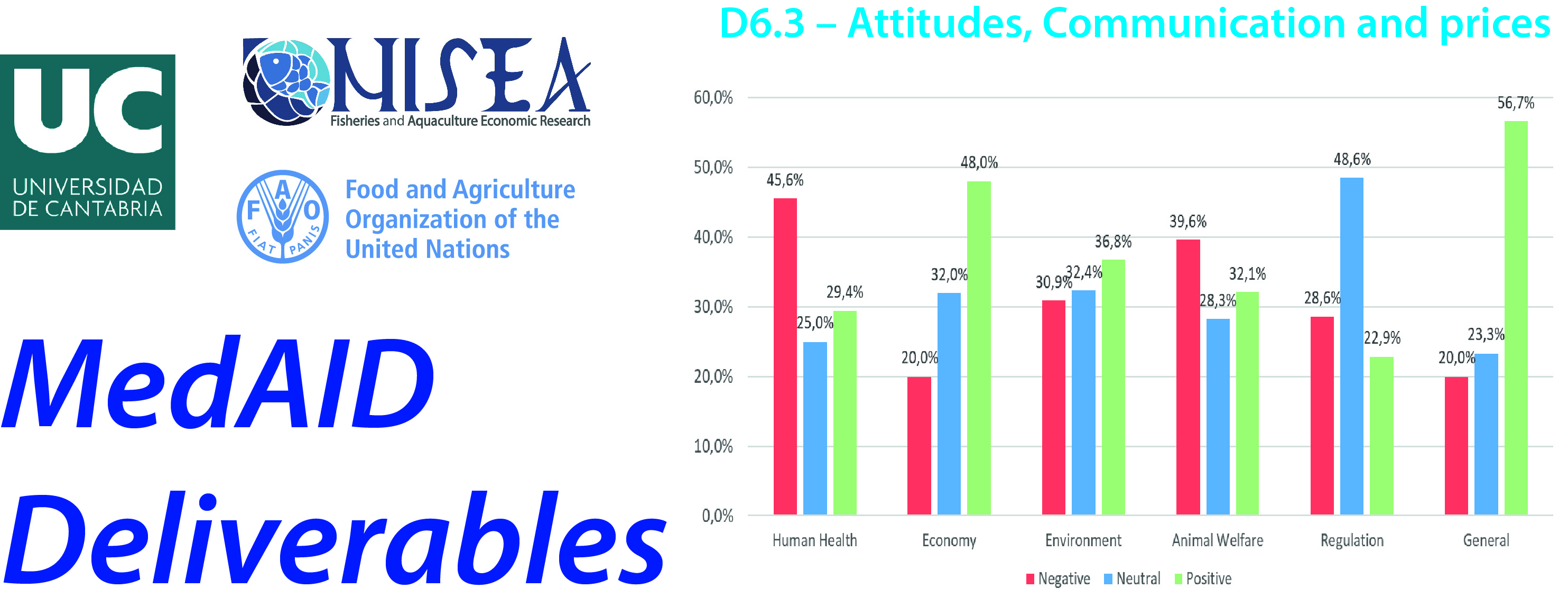The goal of MedAID is to increase the overall competitiveness and sustainability of the Mediterranean marine fish-farming sector, throughout the whole value chain. Despite the positive general trend in the growth of this industry, in recent years, seabream and seabass production has experienced problems of economic performance that affect companies’ competitiveness. Whereas economic research has covered almost all aspects of the economics of other species such as salmon, the same attention has not been given to seabass and seabream. In this context, the MedAID Project, through its Work Package 6 (Improving business performance and development of strategic marketing plans), focuses its research on various topics relevant for the seabass and seabream sector, such as assessment of economic efficiency; assessment of market efficiency; analysis of preferences and consumer behaviour; and economic analysis of technical improvements and innovations.
This Deliverable presents the results and conclusions of two tasks: i) Task 6.3 (Communication tools in Mediterranean aquaculture), whose main goal is to analyse the sources of information that give rise to positive or negative reactions on the demand side, which may affect market volume and prices; and ii) Task 6.4 (Assessment of preferences in the retail/consumer segment), which aims to assess consumers’ and traders/retailers’ preferences and willingness to pay for product attributes by using hedonic and choice models.
Task 6.3. Communication tools in Mediterranean aquaculture
Mass media coverage of a technical sector such as aquaculture can affect consumer behaviour through its effect on individuals’ judgements about these products. Although the research on mass media coverage of food products is quite abundant and up to date, the studies specifically focused on aquaculture are scarce, and most take a descriptive approach. In this regard, it is possible to identify two main streams of research in this field:
• Studies focusing on the analyses of the influence of mass media coverage of aquaculture on the demand of this type of products using inferential statistics methods. Overall, the evidence available to date supports a significant but weak effect of mass media coverage on the demand of aquaculture products.
• Descriptive research, oriented to identify and characterize the news published about this topic in the mass media, using content analysis methods. This line of research is more prolific and, despite its statistical limitations, it provides an interesting contribution by considering both positive and negative impacts of aquaculture.
As regards aquaculture, most studies focus on North America and northern Europe, and the traditional species in those areas, such as salmon. MedAID research provides new insight into the potential impact of mass media coverage of aquaculture in the Mediterranean area, focusing on the fish species traditionally farmed in this region. In particular, we develop three main studies, of both qualitative and quantitative nature:
• STUDY 1. Assessing the effect of news characteristics on aquaculture demand: A semi-quantitative study based on experts’ opinions.
• STUDY 2. Mass media coverage of aquaculture: Identification and content analysis of the news on aquaculture published in the mass media.
• STUDY 3. Proposal and testing of a quantitative index to measure the effect of mass media coverage on aquaculture demand.
First, we conducted an extensive literature review in order to identify and characterize the relevant attributes of the news or pieces of information about aquaculture published in the mass media. In particular, on the basis of the relevant literature we identified the following characteristics: valence/tone of the content; content/topic of the news; size of the piece of information; visual content; geographical scope of the content; depth of discussion about the topic and degree of relationship with aquaculture.
Taking as a basis the relevant attributes of news mentioned, the aim of Study 1 of this research is to provide a quantitative assessment of the potential impact of the different attributes of news on the demand of this type of products. In order to do so, we have used the Delphi Method, a semi-quantitative technique that allows a quantitative value to be assigned to a concept or variable based on the subjective opinion of a panel of experts about the topic. The results have shown that:
• Content: news items that focus on human health and environmental issues have a stronger effect on demand than news items that focus on the economy, animal welfare or regulation.
• Size of the piece of information: smaller news items have a stronger effect on aquaculture demand than long and extensive news items.
• Visual content: news items including pictures or videos have a stronger effect on aquaculture demand.
• Geographical scope of the content: news items with a global scope have a weaker impact on aquaculture demand than national or local news.
• Depth of discussion about the topic: informative news items have a stronger impact on aquaculture demand than technical news.
Study 2 examines the coverage of aquaculture and related themes in mass media in the Mediterranean area. We have focused on the news published in the five more important newspapers in Spain (El Pais, El Mundo, La Vanguardia, ABC, and La Razón) and conducted searches in the newspapers’ online archives, using different keywords related to aquaculture or to themes that may influence the demand of this type of products.
A total of 3,381 news items including at least 1 keyword were found, for a 5-year period, from 2013 to 2017 (both inclusive). All news were read by two referees, who analysed and classified the information in two steps. First, articles that mentioned one of the search keywords but were focused on a topic other than aquaculture were discarded. This resulted in the elimination of 3,076 news items. From the remaining relevant 305 news items with a potential effect on the demand of aquaculture products, 154 contained at least one keyword directly related to aquaculture: The others focused on fish species or the topic of marine resources. Here below, we summarize the main results of the content analysis of the news, comparing the total sample of news items (N=305) with those specifically related to aquaculture (N=154):
• News items from the global sample showed a more positive tone than those from the aquaculture-related sample (Figure 1).
• Human health was the most frequent topic in the global sample, whereas items on aquaculture were economic issues, followed by human health and the environment.
• News focusing on human health in the global sample had a positive tone, whereas in the subsample on aquaculture, the articles about human health and animal welfare had a negative tone.
• Articles in the global sample were more general and slightly shorter than those specifically related to aquaculture, which had more articles with a higher technical approach.
• The subsample of articles on aquaculture included more pictures or videos.
• The international approach was the dominant focus for both the global and the aquaculture subsample.

The index drawn up in Study 3 is based on the most consistent characteristics throughout the period studied and enables analysis of the market impact of the news published. This index was introduced into the equations of a previously tested demand model for seabream on the retail market in Spain. The results point to a significant effect of the number of news items, the valence and the relation with aquaculture on the quantities of seabream sold during the observed period. For higher number of news items, the more specific and more positive the messages, the larger the volumes of seabream sold on the retail markets in the subsequent period. However, this effect is less significant than the price elasticity of demand, which points to price as one of the main tools for moderating the impact of the mass media in the hands of retailers.
Task 6.4. Assessment of preferences in the retail/consumer segment
This task assesses the preferences of consumers and retailers regarding certain product attributes by using the hedonic model (Lancaster, 1966) on a set of products collected by observation at the sales establishment. The main goals consist of analysing the impact of a product’s attributes on current market prices and identifying attributes of seafood products that add value for consumers and retailers. The prices and attributes used for the analysis were collected from retail outlets in Italy, Greece and Spain in different locations in each country. The attributes used for the classification were those directly observed by visual inspection, present on the labels and others highlighted by the retailers. Common attributes in all three countries were size, level of processing and country of origin. The species was also included in order to test for differentiated consumer preferences regarding seabass and seabream.
The distribution of every sample by countries and seasons for a given group of categories in the three most relevant variables are shown in Table 1, and in Figure 2.
Table 1. Distribution of main categories in the samples by countries and seasons
| Variables | Categories | Greece | Italy | Spain | |||
| Summer | Christmas | Summer | Christmas | Summer | Christmas | ||
| Size | < 500g | 88,2% | 86,4% | 84,1% | 90,2% | 59,0% | 35,7% |
| > 500g | 11,8% | 13,6% | 15,9% | 9,8% | 41,0% | 64,3% | |
| Processing level | Unprocessed | 85,9% | 78,5% | 69,7% | 63,8% | 66,7% | 76,2% |
| Processed | 14,1% | 21,5% | 30,3% | 36,2% | 33,3% | 23,8% | |
| Country of origin | Domestic | 80,0% | 100,0% | 51,9% | 17,8% | 46,2% | 47,6% |
| Imported | 20,0% | 0,0% | 48,1% | 82,2% | 53,8% | 52,4% | |

The differences in the models are evident for different seasons (summer and Christmas) as a result of the increase of visitors from abroad due to the strong development of the tourism industry. However, there is a common behaviour connecting attributes and prices corresponding to the preferences of retailers and consumers:
• Species: Greek consumers show preference for seabream while seabass is more appreciated in Italy. The samples in Spain show no significance with regard to the species, concluding that both are priced equally in the shops.
• Size and processing level have a significant influence on price in almost all samples, rising in price with larger sizes and levels of processing. The prices related with size and processing level are directly influenced by increased production costs.
• Country of origin is also an important attribute impacting the price in Italy and Spain, with strong competition from imports. Consumers’ attitudes and behaviour make “locally grown” an interesting tool for improving market returns.
• The identification of domestic production holds a sufficient market share in Spain and Italy in comparison to other schemes related with production systems such as organic and semi intensive farming, both with a very limited supply in the three countries.
Access to the full deliverable

